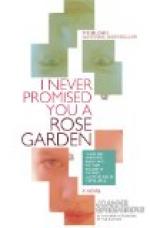[Illustration: PILLAR FOR CORNERS OF ROSE BED.]
Not long ago we invented an inexpensive “pillar” trellis for roses and vines which, standing seven feet high and built about a cedar clothes-pole, the end well coated with tar before setting, is both symmetrical and durable, not burning tender shoots, as do the metal affairs, and costing, if the material is bought and a carpenter hired by the day, the moderate price of two dollars and a half each, including paint, which should be dark green.
[Illustration: ROSE GARDEN WITH OUTSIDE BORDER OF GRAVEL AND GRASS.]
Evan has made a sketch of it for you. He finds it useful in many ways, and in laying out a new garden these pillars, set at corners or at intervals along the walks, serve to break the hot look of a wide expanse and give a certain formality that draws together without being too stiff and artificial.
For little gardens, like yours and mine, I think deep-green paint the best colour for pergola, pillars, seats, plant tubs, and the like. White paint is clean and cheerful, but stains easily. If one has the surroundings and money for marble columns and garden furniture, it must form part of a well-planned whole and not be pitched in at random, but the imitation article, compounded of cement or whitewashed wood, belongs in the region of stage properties or beer gardens!
The little plan I’m sending you needs a bit of ground not less than fifty feet by seventy-five for its development, and that, I think, is well within the limits of your southwest lawn. The pergola can be made of rough cedar posts with the bark left on. Evan says that there are any quantity of cedar trees in your river woods that are to be cleared for the reservoir, and you can probably get them for a song.
The border enclosing the grass plots is four feet in width, which allows you to reach into the centre from either side. Two rows of hybrid perpetuals or three of hybrid tea or summer roses can be planted in these beds, according to their size, thus allowing, at the minimum, for one hundred hybrid perpetuals, fifty hybrid teas, fifty summer roses, and eighteen climbers, nine on either side of the pergola, with four additional for the corner pillars.
The irregular beds in the small lawns should not be planted in set rows, but after the manner of shrubberies. Rugosa roses, if their colours be well chosen, are best for the centre of these beds. They are striking when in flower and decorative in fruit, while the handsome leaves, that are very free from insects, I find most useful as green in arranging other roses the foliage of which is scanty. The pink-and-white damask roses belong here, and the dear, profuse, and graceful Madame Plantier,—a dozen bushes of this hybrid China rose of seven leaflets are not too many. For seventy years it has held undisputed sway among hardy white roses and has become so much a part of old gardens that we are inclined to place its origin too far back in the past among historic roses, because we cannot imagine a time when it was not. This is a rose to pick by the armful, and grown in masses it lends an air of luxury to the simplest garden.




